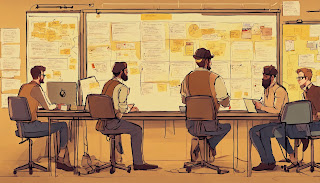The last two decades have witnessed a transformative journey for Agile methodologies, a metamorphosis spurred by the ever-changing landscapes of business. As product managers navigate these dynamic terrains, understanding the evolution of Agile becomes pivotal for effective adaptation and innovation. Let's delve into the intricacies of Agile's evolution, drawing insights from real-world examples.
1. From Scrum to a Kaleidoscope of Frameworks:
The transition from Scrum as the de facto Agile framework to a diverse spectrum, including Kanban, Lean, and SAFe, showcases Agile's adaptive nature. Organizations like Spotify have adopted a combination, or 'Spotify Model,' tailoring Agile to suit their unique contexts.
2. Agile Beyond Software Development:
Originally conceived for software development, Agile has transcended its initial boundaries. Salesforce, for instance, implemented Agile principles across its entire organization, from marketing to customer service, amplifying its impact beyond the coding realm.
3. Integration of DevOps:
The synergy of Agile with DevOps illustrates Agile's evolution in response to the demand for seamless collaboration between development and operations. Companies like Etsy exemplify this integration, leveraging Agile-DevOps synergy for rapid and reliable product releases.
4. Agile Scaling Frameworks:
As enterprises sought to scale Agile practices, frameworks like SAFe (Scaled Agile Framework) emerged. Organizations like Ericsson successfully scaled Agile, aligning large teams and multiple projects cohesively.
5. Embracing Agile Mindset:
Beyond frameworks, Agile has become synonymous with a mindset. Companies like Amazon, through its Leadership Principles, embody the Agile mindset by fostering customer obsession, innovation, and flexibility in their approach.
6. Remote Agile:
The COVID-19 pandemic necessitated Agile's adaptation to remote work. GitLab, an all-remote company, illustrates how Agile principles seamlessly translate into distributed teams, emphasizing collaboration, adaptability, and continuous delivery.
7. Evolution of Agile Tools:
The evolution of tools like Jira, Trello, and Asana reflects Agile's commitment to facilitating collaboration and transparency. Slack, with its real-time communication features, complements Agile by enhancing team connectivity.
8. Continuous Integration and Continuous Delivery (CI/CD):
The evolution of CI/CD pipelines embodies Agile's commitment to continuous improvement. Netflix, renowned for its streaming service, employs CI/CD to swiftly deploy updates, ensuring a seamless user experience.
9. Agile for Innovation:
Agile has evolved to embrace innovation. Google's 'Sprint' methodology, a blend of Design Thinking and Agile, exemplifies how Agile principles can catalyze innovation and problem-solving.
10. Adaptation to Changing Customer Expectations:
Agile's evolution aligns with changing customer expectations. Apple, with its iterative approach to product launches, responds swiftly to market trends, a hallmark of Agile responsiveness.
As the business landscape continually reshapes, Agile methodologies evolve in tandem, proving their resilience and relevance. This evolution, from a singular framework to a diverse set of principles and practices, empowers product managers to navigate complexity and drive innovation. Understanding this evolutionary journey equips product managers with insights to tailor Agile methodologies to their unique contexts, ensuring sustained success in an ever-changing business terrain.




No comments:
Post a Comment